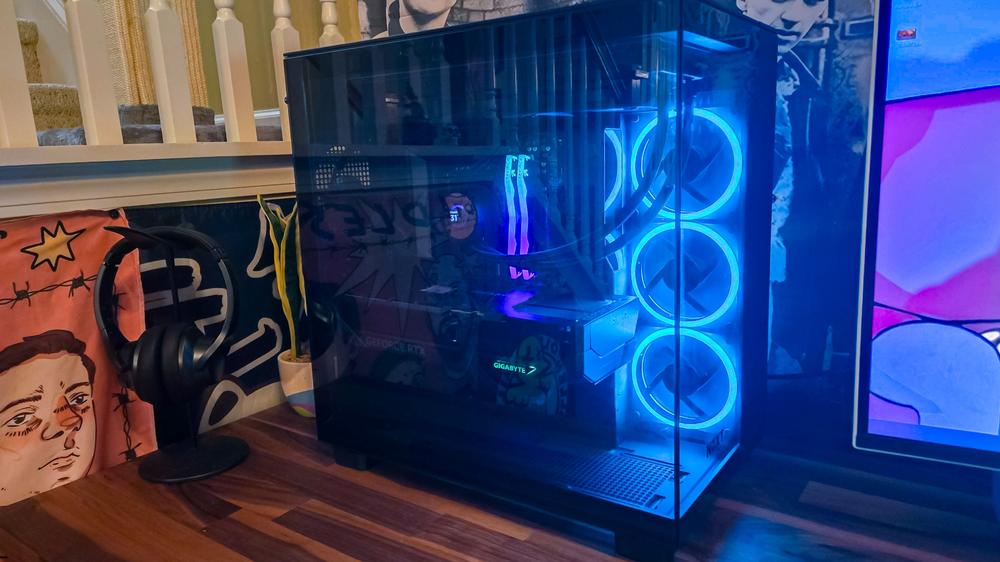Most folks know building a gaming PC can save quite a bit of money, but not everyone's looking to assemble components and tinker before they can jump into a match of their favorite game. Pre-built PCs offer less tech savvy players an opportunity to pick a performance level that matches their budget and get right to the fun. And for those looking to game at 4K with high framerates, the NZXT Player Three Prime might just be one of the most attractive and powerful options available right now.
Design and Features
The NZXT Player Three Prime comes in the company's roomy H9 Elite PC case in either black or white. I love this case's dual-chamber design, which isolates the power supply and SSDs in the chamber behind the other components. This makes cable management much more efficient while allowing the main compartment to remain tidy. It's as gorgeous as it is spacious, sporting tempered glass paneling that wraps from the left side to the front so you can admire the build from multiple angles.
The cable management is so orderly that it'd be a shame to see any of it undone, but there's always a chance you'll want or need to tinker a bit. Luckily, getting into either chamber just requires removing a small screw on the back before popping off the side panel. The top panel features a small lip on the back, so lifting it with medium pressure is enough to remove it, and it snaps back into place with a bit of pressure. Easy peasy.
The top of the H9 Elite provides one USB-C (3.2 Gen 2x2) port and two USB-A (3.2 Gen 1) ports, as well as a combo audio jack for headphones or microphones. That's fairly standard, but there are plenty more ports along the rear, including a total of ten USB-A ports, one USB-C port, and an ethernet port. There are also HDMI and DisplayPort connections on the motherboard I/O, but those are more for audio or troubleshooting – you should definitely be plugging into one of the ports on the GPU for video output.
There's plenty of customizable RGB, too, which can be easily changed via the NZXT Cam app. You can set unique lighting for each fan, both memory sticks, and the Gigabyte logo on the GPU. You can even personalize the 360mm AIO's 1.5-inch LCD display with a clock, infographics for GPU/CPU temps, or even a GIF. So, naturally, I put an Ace Ventura GIF on mine because I'm an adult and can do what I want.
Though I love the way NZXT takes advantage of the H9 Elite's features, there's no denying that the Player Three Prime is a large, heavy pre-built that won't fit in everyone's setup. At 19.49 inches tall and 18.35 inches in length, it takes up a significant amount of space on my desk. And considering it weighs around 40lbs, moving it can be cumbersome – especially if you've got a bad back like me.
Speaking of moving it around, I'm happy to report that my Player Three Prime arrived densely packed inside and out to prevent any of its expensive components from getting out of whack during shipment. In a time when some companies don't take as many precautions to protect the delicate pieces housed within their cases, it's wonderful to see NZXT taking this concern seriously.
Go Big Or Go Bigger
NZXT changes up its configurations randomly – including at least once during the time between me receiving my unit and reviewing it – but at the time of this writing, the base Player Three Prime comes with a GeForce RTX 5080, Intel Core Ultra 9 285K, 32GB DDR5 RAM, and 2TB NVMe M.2 SSD for $3,499. Every configuration above it, however, includes an RTX 5090, which means you'll see a minimum price bump of $1,000.
The most enhanced unit currently available is $4,899, which includes an RTX 5090, 128GB RAM, and a whopping 8TB of storage. There's no denying that the 128GB RAM is brag-worthy, and it could be a good call if you're running a streaming setup or doing intense video rendering, but it's absolutely overkill for gaming at the moment. I'd argue that the $4,699 version with 64GB should be more than enough for most folks.
With either of these configurations, though, the upgrade to an AMD Ryzen 7 9800X3D is the real reason to dish out a few hundred extra bucks. The Core Ultra 9 285K is a flagship processor with excellent productivity and gaming performance, but the 9800X3D blows it out of the water for gaming, specifically, while also running a bit cooler in most cases. Since it's paired with the upgrade to the RTX 5090, this makes for substantial future-proofing.
All of this is super premium stuff for the most frame-chasing enthusiasts, so none of it is required to have a good gaming experience. Unless you're determined to spare no expense in pursuit of bleeding-edge tech, the base configuration of the Player Three Prime is a perfectly safe choice that will keep you satisfied for quite a few years without needing any meaningful upgrades.
Unfortunately, you're never able to be quite sure which components you'll receive in the Player Three Prime. A glance through its tech specs on the NZXT website makes it clear that the motherboard, memory, and storage brands used in their systems vary. This isn't entirely unusual in the world of pre-builts, but it does mean that you're essentially playing the lottery. You could get, say, a brand of SSD that is known for being extremely reliable or one that has a higher failure rate than others. The fact that you don't get to know ahead of time just, well, sucks –— especially when you're paying so much money for a PC.
The wording on NZXT’s site also sends mixed signals about what to expect from the Player Three Prime's CPU cooler. The "overview" section mentions that it will sport a Kraken 360, while the image carousel at the top of the page states it only comes with a Kraken 280. I can confirm that it does come with the Kraken 360, but little miscommunications like this –- along with the random configuration updates and inconsistency with certain components – can make the buying process more frustrating than it needs to be.
That said, NZXT does offer free returns within 14 days if you find that you're unsatisfied with how your PC turned out. It also offers a decent 2-year warranty, meaning you stand a fairly good chance of having any failed components replaced.
Performance
As someone who plays a lot of my games on consoles, I'm simply not a graphics or performance snob. I've been using a pre-built with a 4070 Super since last year, and I doubt I've ever spent more than thirty seconds in the graphics settings of any game I've played on it. But that hasn't stopped me from being wildly impressed with the overall performance leap I've seen from the Player Three Prime during my time with it over the past few weeks.
NZXT sent me an upgraded configuration with an RTX 5090, AMD Ryzen 7 9800X3D, and 64GB RAM. Unsurprisingly, it dominated every game I maxed out at 4K while maintaining very reasonable noise and cooling ranges.
Cyberpunk 2077's Ray Tracing Ultra preset with DLSS in performance mode consistently hovered around 125 fps with no frame generation. Black Myth: Wukong, despite being notorious for its poor optimization, was still getting between 100-110 fps using the Cinematic preset at TK resolution, with DLSS set to 40%.
3DMark Steel Nomad14441 points3DMark Speed Way14356 points3DMark Port Royal37623 pointsCyberpunk 2077 (Ray Tracing Ultra, 4K, DLSS Performance)129 fpsCyberpunk 2077 (Ray Tracing Ultra, 4K, DLSS Performance, Frame Generation 2x)221 fpsCyberpunk 2077 (Ray Tracing Ultra, 4K, DLSS Performance, Frame Generation 4x) 375 fpsCall of Duty: Black Ops 6 (Extreme, 4K DLSS Performance)184 fpsCall of Duty: Black Ops 6 (Extreme, 4K, DLSS Performance, Frame Gen)249 fpsBlack Myth: Wukong (Cinematic, 4K, DLSS 40%)103 fpsBlack Myth: Wukong (Cinematic, 4K, DLSS 40%, Framerate Generation x2)169 fpsBlack Myth: Wukong (Cinematic, 4K, DLSS 40%, Framerate Generation x4)295 fpsTotal War: Warhammer 3 (Ultra, 4K) 163 fpsProcyon Office Productivity8969 pointsGames like these can benefit from frame generation to reach some outrageous framerates (often beyond the refresh rate of all but the highest-end monitors). I'm not very sensitive to any added latency that comes with frame generation — especially in single-player games — so I enjoyed letting the Player Three Prime flex its muscles just to watch the big, fancy numbers dance around on the top left of the screen while I played.
The only game to (barely) average under 100 fps was Metro Exodus, but that's not too abnormal. The game is known for being problematic even on exceptional hardware, and its benchmark tool pushes things even harder than most gameplay sequences, not to mention that we run this benchmark with ray tracing and without any upscaling.
Do note, though, that the upgraded specs in my Player Three Prime unit make for a consequential bump in performance over the base configuration, so the cheaper version simply won't put up numbers quite as high. Even so, it's like comparing different models of Ferraris — no matter which you pick, you're getting an immensely capable machine.
Billy Givens is a freelancer at IGN with over a decade of experience writing gaming, film, and tech content. His work can also be found on GameSpot, USA Today, Digital Trends, Tom's Guide, and more. You'll find him blabbering on about video games and more on Twitter at @mektige.

 SpaceX disables 2,500 Starlink terminals allegedly used by Asian scam centers
SpaceX disables 2,500 Starlink terminals allegedly used by Asian scam centers